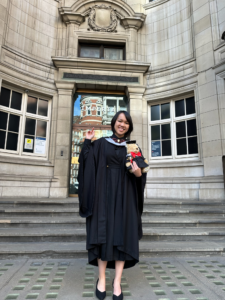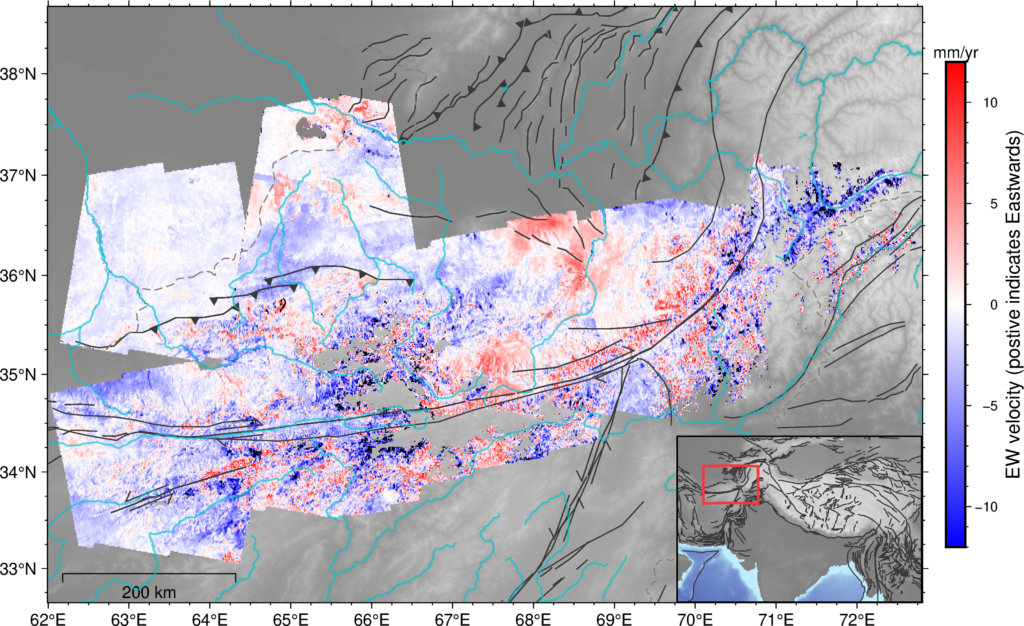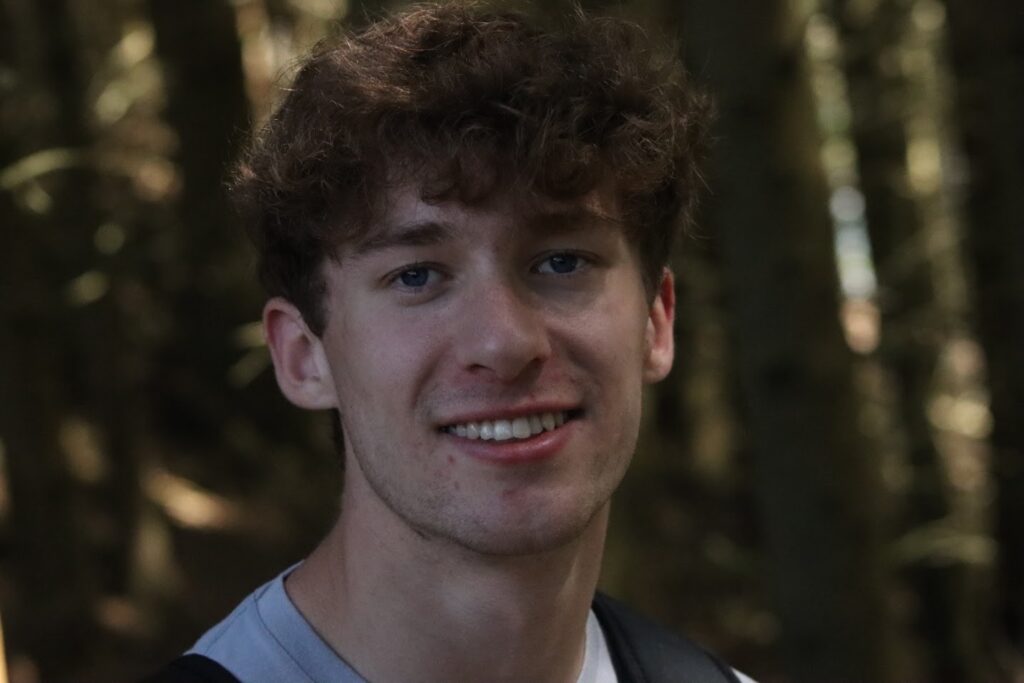Summer 2024
Name of internship student: Rochelle Pun (Imperial College London)
Project title:Kinematics of the Hindu Kush from InSAR Velocity Measurements
Supervisors: Dr Milan Lazecky, Dr John Elliott (University of Leeds)
Bio: I am currently pursuing a Master’s degree in Geophysics at Imperial College London. Growing up in Hong Kong, a tectonically quiet region where geology is often undervalued and overlooked, I developed a strong interest in active tectonic processes following the live-streamed coverage of the 2011 Japan Tohoku earthquake. After organising numerous geological field trips around Hong Kong, I was inspired to relocate to London three years ago to pursue my goal of conducting research in the earth sciences. As part of my Master’s degree, I am also embracing my newfound passion for programming by applying data science and machine learning techniques to enhance research in geophysics.
Project: Afghanistan is prone to large, devastating earthquakes due to its location within a major tectonic collision zone. However, due to limited accessibility and a lack of GPS stations, research into the region’s active tectonics has been restricted. Throughout this project, we applied state-of-the-art processing techniques to satellite data in order to image surface deformation in central Afghanistan. Using analytical modelling, we then constrained key information about the seismic activity of the Herat fault. While further research is necessary to fully understand the dynamics at play, this work provides valuable insights into assessing the seismic hazard of the region, particularly for the cities of Herat and Kabul.
Outputs: This project was summarised in the following report COMET_Student_Internship_Report. There, we delve into the technicalities behind InSAR processing and time-series analysis to produce regional east-west and vertical deformation-rate maps covering central Afghanistan. Following this, we applied analytical modelling to provide the first-ever modern slip rate constraints on the Herat fault, revealing the complex fault dynamics and tectonics within the region.
I had the opportunity to present my findings to the Institute of Geophysics and Tectonics at the University of Leeds, and I will be presenting at the COMET student meeting in January 2025 at the University of Bristol.
As a side project, we also developed an interactive GMT/pyGMT visualizer in Jupyter notebook. This tool allows users to generate interactive maps from GMT/PyGMT figures where you can click to retrieve map coordinates. This code is freely available on my GitHub https://github.com/chelle0425/IntPyGMT, and it will be integrated into COMET’s LiCSBAS tutorial materials used during the international COMET InSAR Workshop 2024.
The overall experience: My COMET internship was an incredibly rewarding experience that provided me with first-hand experience of what research really involves. This project thoroughly deepened my understanding of InSAR imaging and processing for continental deformation, all within an environment where I felt encouraged to ask questions and delve into the nuances of scientific research. Interestingly, remote sensing was one of the few subjects I struggled with during my undergraduate studies. Not only was I able to confront that challenge directly, the rigorous coding projects cultivated my passion for scientific data analysis, which I am excited to refine further through my Master’s studies.
Milan Lazecky, my primary supervisor, was an exceptional mentor, who taught me invaluable lessons from tackling research with relentless curiosity to problem-solving through the perspective of a scientific algorithm developer. John Elliott, my other supervisor, was also incredibly supportive, and I always left our discussions with newfound insight and a deeper understanding of the topic at hand. Outside of research, I appreciated the supportive atmosphere of the research group, whether it was through insightful lunchtime discussions or casual music jams.
Overall, I am deeply grateful for this experience, as it has shaped my growth as a researcher and solidified my desire to pursue a PhD in geosciences.
Name of internship student: Ben Mackley (University of Plymouth)
Project title: Does Crustal Heterogeneity Influence Volcano Deformation?
Supervisors: Dr Stanley Yip Tze Hou and Dr Craig Magee (University of Leeds)
Bio: I’m currently a 3rd year student at the University of Plymouth, studying the MGeol degree (Geology with an integrated masters). I’m from Bolton originally and have always had an interest in geology since I was in primary school, endlessly watching documentaries about volcanoes, earthquakes, the formation of the Earth and just about anything else related! In high school and college, I have been lucky to have been given the option to study geology, which further honed my interest in the subject. Growing up in Bolton, I was always a stone’s throw away from the Lake District, where much of my holidays were spent, with my family climbing the peaks and taking rocks back down. Other interests include my love for being in nature, rock music and guitar!
Going to university opened an entire new world to me. Plymouth’s convenient location next to Dartmoor and Devon’s coastland, helped fuel my interest in the outdoors. Throughout my time in Plymouth, I have had a growing interest in academia, although I never knew which path to go down, I realised I was most engaged in all the various aspects of volcanology. I never thought I would end up getting the chance to have a taste of what this path would be like until I started the COMET internship! I’m now more excited than ever to pursue my interest in Volcanology, wherever it takes me!
Project: The question in my project was as follows: Does crustal heterogeneity affect volcano deformation? We can model the ground deformation (detected using GPS, tiltmeters, InSAR etc.) caused by a magma chamber inflating under the ground (often a precursor to an eruption) to understand where the magma chamber is and how big it is (among other things).
Earth’s crust is complex and so are the magma chambers themselves. Sometimes the simpler analytical models aren’t accurate, so all of these other complexities must be considered. Numerical modelling (in my case using COMSOL Multiphysics), allowed me to explore a range of different things (Topography, complex intrusion geometries, layering, faults in the ground etc.) and how they affect ground deformation.
A large part of the project was spent running experiments that tested this modelling software against analogue model (lab-made) of a balloon inflating into a gelatine mixture. Because we know all of the parameters of the analogue model (strength of the gelatine, the size and depth of the balloon), we can accurately benchmark the numerical model I made on COMSOL against it, allowing us to gain more insight into the validity of numerical modelling in the real world.
Outputs: From the research, I was able to make detailed guides on how to reproduce the numerical models of the gelatine tank experiment, as well as some of the other models I tested.
The results of the experiment showed that the numerical model was able to simulate the balloon expanding and deforming the gelatine, with the ability to look at the stresses on and around the balloon. This provided insight into how the tank size affects the results, with deformation against the sides of the tank occurring if it is too small. The large, cuboid tank mitigated this affect more, making the model a more realistic fit to real life, where the crustal domain can be considered as near infinite.
The overall experience: Going into the internship, I was very uncertain about what it would be like to work in a professional academic environment, but very quickly realised it is a very interconnected place, where people share their skills with others, and everyone seems to help each other! I was able to get an insight into the massive range of different research topics being worked on in Leeds, from flood hazards and earthquakes to volcanology.
The first two weeks I spent learning about the topic of my project with the help from my supervisors, who always seemed to be ready to help when I needed it! As the internship went on, I was allowed to tackle the project with complete freedom on the aspect I was most interested (Numerical modelling using COMSOL), but was given as much guidance as needed to use these new skills to help contribute to the project. I got more and more interested in the project and the research surrounding it! I really felt like I was part of COMET while I was doing the project, and my thoughts, opinions and ideas felt valued at every level, which has since boosted my confidence immensely.
I made meaningful contacts and got the chance to make friends with the other interns there, and we all got on very well, frequently meeting at the weekends or after work!
The whole experience was both eye opening and very humbling, and I feel much more prepared for an academic life after my degree than I could’ve possibly imagined.
Summer 2023
Name of internship student: Geri Peykova (University of Cambridge)
Project title: Exploring plume dynamics in the La Soufrière St Vincent eruptions of April 2021
Supervisors: Dr. Isabelle Taylor, Prof. Don Grainger, Prof. David Pyle (University of Oxford)
Bio: In 2020 I started my Bachelor’s degree in Natural Sciences at the University of Cambridge, with the intention to specialize in Physics. During my coursework, I took several geology classes, and really liked their observational approach and all the exciting field trips across the UK. This is when my fascination with volcanoes started too, especially after witnessing the 2021 eruption of Fagradalsfjall in Iceland. In the summer of 2022, I combined my love for the outdoors, travel and geology and organized a mapping expedition to the High Himalayas in Ladakh, India, at 4000m, along with two friends. For my Master’s degree at Cambridge, I am shifting my focus slightly to delve into Astrophysics, complementing my existing geology knowledge with planetary science courses. Currently, my academic goals include exploring computational modelling of planetary processes and joining a research expedition to Antarctica.
Project: The 2021 eruption of La Soufriere volcano on the island of St Vincent consisted of a series of eruptive events occurring over 14 days. This project focuses on understanding the dynamics
of the ash plumes of the different events during this period and determining the ascent rates by accurately estimating plume heights. A novel method based on the observation of waves within the plume was developed. This method uses 1-minute resolution satellite imagery from the Advanced Baseline Imager (ABI) on board the GOES-East Satellite to track the evolution of the volcanic plume during each event. By analyzing the formation of buoyancy waves and the ambient conditions, the plume heights during multiple events were estimated and compared to heights obtained through other methods. The insights gained from this analysis contribute to our understanding of volcanic eruption dynamics and hazard management.
Outputs: A new method for estimating the height of volcanic ash plumes by analyzing the formation of waves within them was developed. One of the advantages of this method is that it provides a single solution for plumes near the tropopause, where one of the most common methods that uses the brightness temperature usually produces two possible solutions. Moreover, it is not limited to daylight observation as direct imaging is. The method was applied to a range of events from the 2021 La Soufriere eruption and the results closely matched height estimates obtained through other methods. Accurate height estimates allowed ascent rates to be calculated as well. Further testing of this method is necessary, both for events from the La Soufriere eruption and, when data is available, in other volcanic eruptions.
The findings of the project were summarized in a report, published on the EODG website. Additionally, I presented my work at one of the group meetings in front of the research group and other members of the Physics and Earth Sciences departments and the COMET Student meeting in January 2024 at the University of Leeds.
Click here to read Geri’s blogpost on detailed methods to measure volcanic plume heights.
The overall experience: I enjoyed my internship as it gave me a taste of what research is like. I really liked the open-ended nature of my project, giving me the freedom to try different things before deciding on the direction I wanted to take. The whole experience allowed me to apply and enhance my coding skills and taught me how to work with satellite data, which I think will be very handy in the future.
My research group was incredibly supportive and always ready to help and created a friendly working environment. I really appreciate it that I got to do a presentation in front of the group and other members of the department as it was a great learning experience.
Overall, I’m grateful for the experience and knowledge I’ve gained through this internship.
Summer 2022
Name of internship student: Francesca (Frankie) Butler (University of Aberdeen)
Project title: Improving Building Exposure Datasets using High-Res Imagery and Deep Learning
Supervisors: Dr. Scott Watson and Dr. John Elliott (University of Leeds)
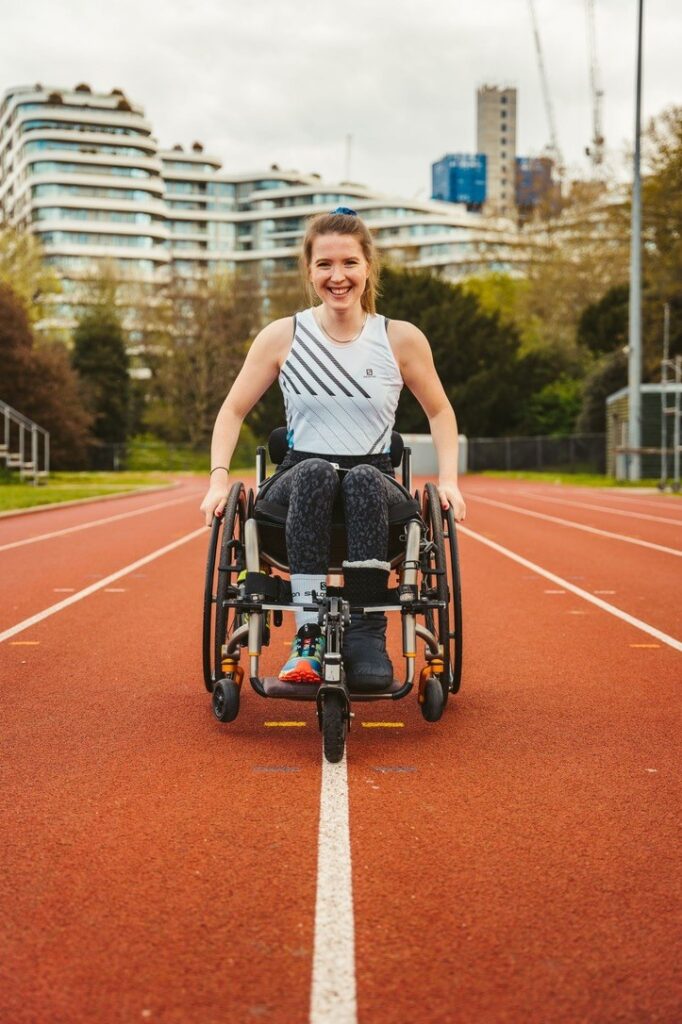
Bio: Final Year Undergraduate at the University of Aberdeen, reading Geology and Petroleum Geology, with a specific interest in pursuing a PhD in Volcanology, Magma Mixing.
Following a life changing injury, I have had to look deeper at remote Geology, attend virtual field trips, GIS Mapping and most recently, the new frontier of Deep Learning in GIS.
I am also interested in science communication, and I am part of the Geoscience academic community on Twitter – @frankiealoise I enjoy presenting ideas/research and documenting my journey as a disabled geologist, both in the field and the lab.
I thoroughly enjoyed the COMET internship as it gave me the opportunity to learn new skills and speak at the annual student COMET meeting, combining PhD style research with Science communication and remote Geology/ Geoscience work!
Project:
Project title: ‘Improving Building Exposure Datasets using High-res Imagery and Deep Learning’
Testing the application of a variety of deep learning models to an area of Kathmandu and assessing transferability and improvements
Independent 6-week summer research project, fully funded by NERC, COMET and the University of Leeds.
Manually mapping buildings in Kathmandu, Nepal from high resolution satellite imagery. Using QGIS and ARCGIS to draw polygonal outlines around buildings.
These manually collected outlines were then used to train Deep Learning Models to identify buildings with the end goal to create a pre-trained Deep Learning model for Kathmandu. Investigated the use of Non-Differentiated Vegetation Index (NDVI) masks to improve the accuracy assessment score and improve the overall accuracy of the model.
These deep learning models are important for mapping building footprints quickly. Kathmandu currently has no established model and this will help to inform future planning and humanitarian response following natural disasters.
Outputs:
Partially trained Deep Learning Models for Kathmandu.
Accuracy Assessment Scores for Pre-trained deep learning models.
Helped to define a direction for future research for my Supervisor Dr Scott Watson; the use of Non-Differentiated Vegetation Index (NDVI).
15 Minute presentation at the NERC COMET student meeting in person in Manchester (January 15th 2023)
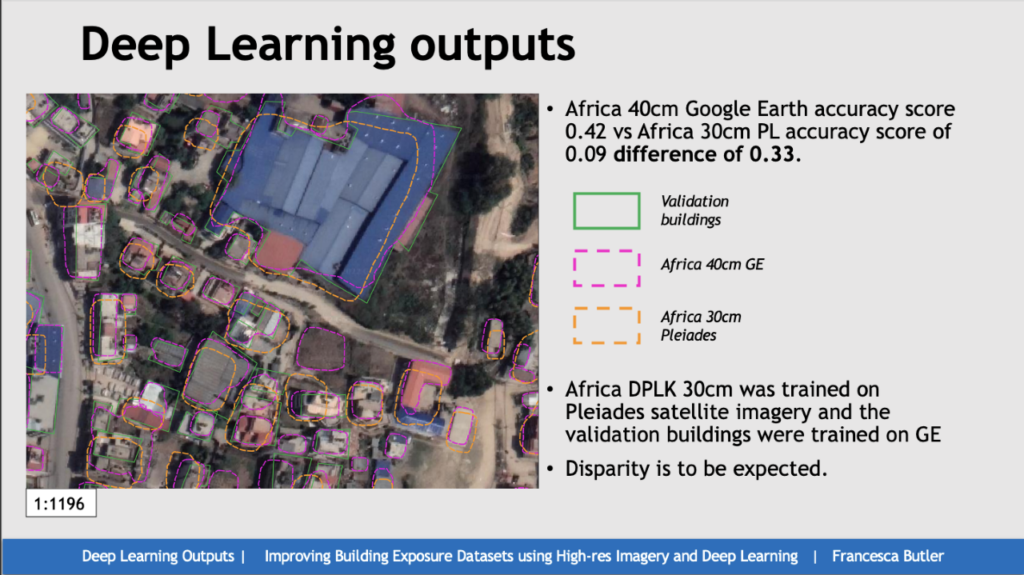
The overall experience:
I thoroughly enjoyed the NERC summer internship programme.
I learnt so much about the process and approach you must have to research projects.
I felt I was learning and contributing to research at the forefront of the field.
Deep Learning programmes are becoming more prevalent within Geoscience, the work I did with Scott has helped me throughout my current Geology degree. I have attended PhD and Post-Doc talks on Deep Learning, and I understood their approach and felt I could ask relevant questions.
Scott was an excellent supervisor, I had enough free reign to investigate areas I felt
needed investigating, but I also had enough guidance. I felt I could ask any questions without fear of retribution.
I learnt how to use some incredibly useful programmes that I am integrating into my own research.
It was interesting as the project was within an area of geoscience that I am not wholly comfortable with- coding and new programmes. But the process of learning how to use them, making mistakes and learning how to rectify them, was really important for my overall development as a scientist.
This project has helped to solidify that I would like to pursue a PhD in Geology.
I completed this project whilst recovering from a serious life-changing injury. The understanding and compassion from all staff members allowed me to complete the work to a high standard whilst not jeopardising my recovery.
I truly enjoyed the experience, thank you to Leeds and NERC for this experience!

